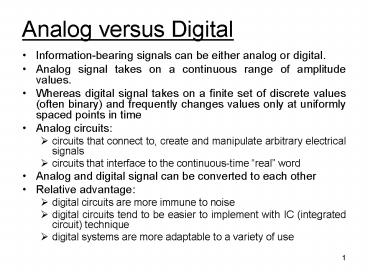Analog versus Digital - PowerPoint PPT Presentation
1 / 6
Title:
Analog versus Digital
Description:
... of digital circuits actually increased the amount of analog electronics in existence. Nowdays, most electronic systems contain both analog and digital (called ... – PowerPoint PPT presentation
Number of Views:118
Avg rating:3.0/5.0
Title: Analog versus Digital
1
Analog versus Digital
- Information-bearing signals can be either analog
or digital. - Analog signal takes on a continuous range of
amplitude values. - Whereas digital signal takes on a finite set of
discrete values (often binary) and frequently
changes values only at uniformly spaced points in
time - Analog circuits
- circuits that connect to, create and manipulate
arbitrary electrical signals - circuits that interface to the continuous-time
real word - Analog and digital signal can be converted to
each other - Relative advantage
- digital circuits are more immune to noise
- digital circuits tend to be easier to implement
with IC (integrated circuit) technique - digital systems are more adaptable to a variety
of use
2
So why do we still study analog?
- The real world is analog
- Many of the inputs and outputs of electronic
systems are analog signal - Many electronic systems, particularly those
dealing with low signal amplitudes or very high
frequency required analog approach - The dominance of digital circuits actually
increased the amount of analog electronics in
existence - Nowdays, most electronic systems contain both
analog and digital (called Mixed-signal, also
Mixed-signal SoC (System on Chip)) - Lots of most challenging design problems are
analog - Good analog circuit designers are scarce (very
well compensated, gain lots of respect, regarded
as artists because of the creative circuit
design they do)
3
Electronic system design process
System specification
Topology synthesis
System functionality
Solution approaches
Design system block diagram including block
specifications
Our interest lies here
Design each block
Topology selection
Construct prototype
Test prototype
Production
4
Basic amplifier concepts
- Amplification of low amplitude signal is one of
many functions that is best handled by analog
circuits We need amplifiers - Ideally, an amplifier produces an output signal
with the same waveshape as the input signal, but
with a larger amplitude - Output signal , where is
called the voltage gain of the amplifier.
5
Voltage amplifier model
Voltage amplifier
- A voltage amplifier should have a large input
impedance and a small output impedance - is the open circuit voltage gain, the actual
gain - is different if
impedance are non-ideal - There are also other models to model the gain
property of the amplifiers, e.g.
current-amplifier model, transconductance-amplifie
r models and transresistance-amplifier models
transconductance-amplifier model
6
A few other important concepts
- Any electrical signal can be considered to
consist of a sum of sinusoidal components having
various frequencies, phases and amplitudes.
(Spectrum?) - Amplifier gain is complex (which changes both the
amplitude and phase of the input signal) - Amplifier gain is a function of the frequency (so
it is important to the frequency characteristic
of the input signal) - Differential input amplifiers have two input
sources - Real amplifiers also respond to common mode
signal. The gain for common mode signal is
denoted as , the output of the differential
amplifier is then - and the ratio
is called common mode
reject ratio (CMRR)
Noninverting terminal
Differential amplifier
Inverting terminal































